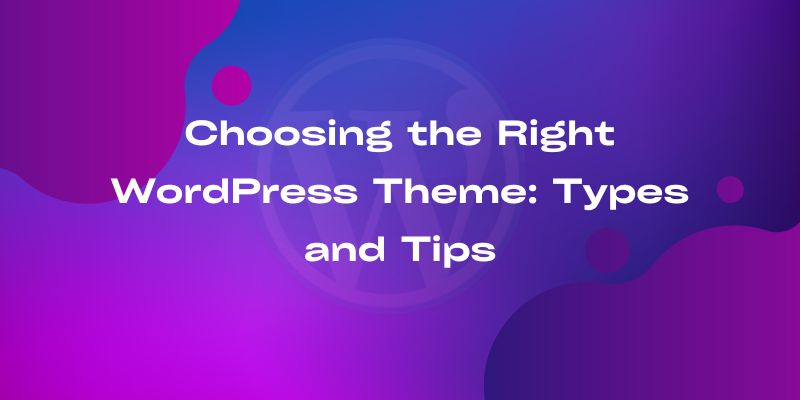
Choosing the Right WordPress Theme: Types and Tips
First, I will explain to you what a WordPress theme is that. More than likely, if you are using WordPress as your Content Management System then you are familiar with the term WordPress Theme. Themes are important in a website’s design since it becomes possible to design a website well without knowledge of code.
WordPress consumers can select the appropriate theme and determine the font and color they wish their site to display its brand logo accurately. This lesson will describe the basic meaning of a WordPress theme and the differences between the theme and the template. You will also come across different kinds of themes and how to choose the right one for your WordPress website.
A WordPress Theme: What Is It?
A WordPress theme is a collection of styles, scripts, and templates that modify the look of a WordPress website without changing the core program. For easy modification, a page builder is included with many themes.
WordPress Themes: What Can They Do?
Owners of websites may establish a website using WordPress themes without having any coding experience. Activating a theme is as easy as uploading the file to your WordPress admin area after buying it from a third-party shop or from the WordPress directory.
With theme elements like these, a theme may significantly alter the appearance of your website.
- Menus for navigation.
- Customized headers.
- Personalized backgrounds.
- Side columns.
- Send out formats.
A default theme that is lightweight and basic is installed when a new WordPress website is created. You have the option to use it or switch it to a paid or free theme. Free themes are also included in certain WordPress hosting packages.
Because each WordPress theme frequently has its unique appearance and function, be aware that the design components may change considerably if you replace them. For instance, some could work well for intricate corporate websites, while others might design ideal for uncomplicated portfolios.
Users are limited to using one theme at a time by default. Install a plugin such as Numerous Themes to enable numerous WordPress themes.
Unlike a WordPress plugin that improves a website for a specific purpose, a theme shouldn’t have the necessary features. Users who switch themes won’t miss out on any important functionality as a result.
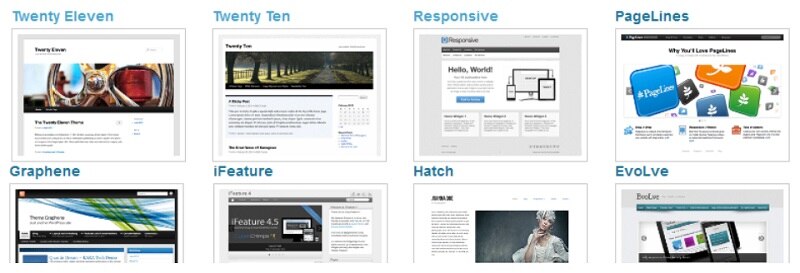
What Differentiates a WordPress Theme from a Template?
The number of pages that WordPress themes and templates may be applied to is the difference between them. A template specifies a layout for a single page, while a theme controls how a website looks as a whole.
There are two necessary WordPress theme files:
- Index.php is the name of the main WordPress theme file.
- The main style file is called Style.css.
Other files, like these, may also be included in the theme’s folder:
- PHP files, such as the template files needed to create traditional themes.
- HTML files and blocks for creating block themes.
- Stylesheet for CSS.
- Pictures.
- JavaScript.
Some WordPress themes provide multiple template files that may be further customized inside the primary theme. A theme may, for instance, include two landing page templates (a full-width and a narrow-width one) or it could have distinct design elements for blog and portfolio sites.
WordPress theme categories
Not to include the ones on marketplaces, the WordPress theme directory alone has over 9,000 free themes.
WordPress organizes its themes into categories to make it easier for users to filter themes based on particular requirements:
- Layout: This sorts themes into groups based on the layout of the page, such a grid or three columns.
- Features: These are certain qualities that a lot of people search for in a theme, such as footer widgets and support for RTL languages.
- Subject: Classifies themes (e.g., portfolio and education themes) based on their function and specialty.
In addition to the categories listed in the WordPress directory’s filter function, we will go into further detail about various kinds of WordPress themes below, beginning with free and paid themes.
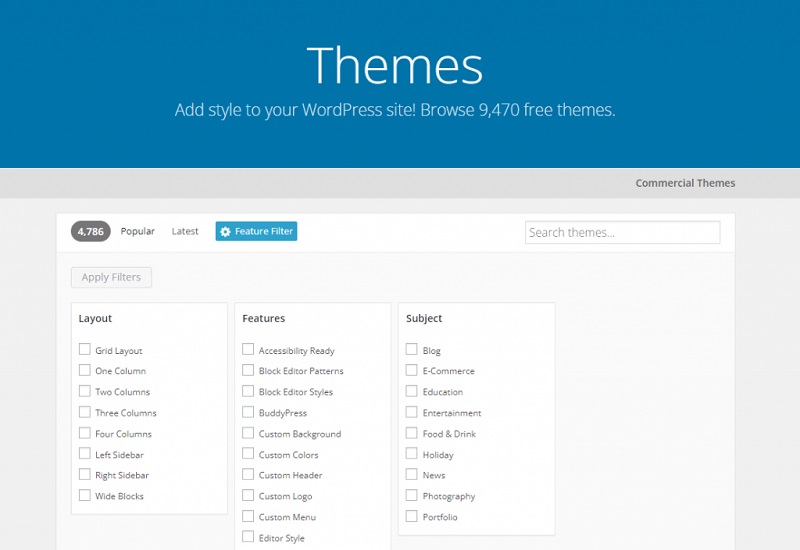
Compare Premium and Free WordPress Themes
Free WordPress themes are usually produced by independent developers and luxury suppliers as a teaser for their paid offerings.
They are a great choice for consumers on a tight budget. Moreover, they must undergo a rigorous review procedure to be made available in the WordPress.org theme directory. Users can feel secure in their quality and security as a consequence.
The fact that users may explore and activate free themes straight from the admin dashboard makes them much more accessible.
One of the biggest disadvantages of free WordPress themes is the lack of documentation or direct creator assistance. Developers are not required to offer help through the WordPress forums, although several do.
This might be a problem if you need to adjust a theme element or debug a glitch.
Their lack of originality is another negative. The design of your website may appear generic because free themes are frequently accessible and have few modification options; to make it look unique, you’ll need to use a page builder or some coding expertise.
The premium version, in contrast to free themes, may be bought from independent WordPress theme stores like:
- Elegant Themes
- WPAstra
- StudioPress
- ThemeForest
- Mojo Marketplace
As an alternative, get a premium theme straight from theme providers like ThemeIsle and aThemes. Dedicated developers frequently offer excellent customer service and generally have a variety of themes in their portfolios. They could not, however, show user ratings as in a WordPress theme directory or theme marketplace.
The following are a few of the main benefits of utilizing premium WordPress themes:
- Custom visuals and content, along with search engine optimization (SEO) tools, are examples of advanced features.
- Personalized possibilities abound with this one-of-a-kind website design, which includes several themes, integrated drag-and-drop builders, and a vast color palette.
- Consistent assistance – contact us via phone, email, or forum.
However, sophisticated features in high-end WordPress themes might overload the server, cause code to bloat, and slow down download times. In addition to its potentially expensive pricing, they could also demand an additional monthly or yearly license charge.
Comparing Multipurpose and Niche Themes
A versatile theme fills a variety of roles and needs. Regardless of the industry, it often has several pages, widgets, and extensions to provide consumers with additional customization choices for their websites.
Neve and Divi are two of the most well-liked themes in this area.
Because of their unique characteristics, they work well not only as a blog or portfolio theme but also as a WooCommerce theme.
A niche theme, on the other hand, frequently focuses on certain markets or subjects, including blogs, eCommerce sites, or entertainment websites.
Although niche themes may offer fewer functionality or customization options than versatile themes, they nonetheless meet all the necessary specifications for your particular use case.
One great example in this genre is Personalias. With a grid layout, a hero picture, and a sidebar displaying the most recent comments and posts, this blog theme has a simple yet elegant layout.
Child Themes against Parent Themes
A parent theme is a full theme that comes with all the necessary WordPress template files.
Conversely, a child theme retains its parent theme’s fundamental design and functionality but lets developers make modifications without affecting the parent theme.
The description of a WordPress theme will indicate if it is a child theme, and the sidebar will display a label such as “This is a child theme of X,” as seen in the example below.
Unique Themes
To obtain a distinctive appearance and features, such as animation and 3D integration, a custom theme is a great option. It works well for niche websites, such as e-commerce sites.
A custom theme’s price might vary depending on several variables, including the developer’s location and the project’s schedule. On the other hand, the cost may range from $1,750 for a basic custom theme to $25,000 for a project with intricate features.
Ways to Select a WordPress Theme?
When choosing a theme for your WordPress website, keep the following in mind:
1. Recognize Your Needs
Whether it is an online business, a digital portfolio, or just a basic blog, determining the objective of the website is the first step towards selecting the perfect WordPress theme.
Different features and layouts will be required for each of them. To draw in clients, a photographic portfolio could benefit from animations and a gallery layout, whereas portfolio websites might work better with a simple, one-page WordPress theme.
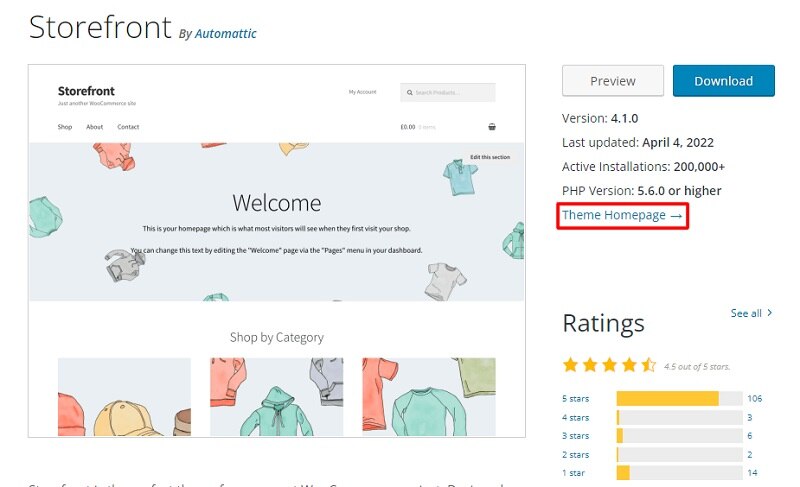
Make a list of the features you would want to see on your website. Some characteristics to search for in a WordPress theme are as follows:
- Widgets for social networking
- Availability
- Assistance with translation
- The homepage’s contact form
- A forum or comment section
- Compatibility with eCommerce
List your top choices for the layout and editor styles of your website after that. Although a lot of WordPress themes are customizable, to expedite the development process, we advise selecting the theme that best represents your brand.
Examining the sample websites for a WordPress theme is excellent advice. If you choose a free theme, click the Theme Homepage link on the official directory. After that, select the View Demo Sites option. Be aware that this button may go by a different name on other websites.
2. Examine the options for customization
Even when a user finds a theme that works well for their business, they may still want to make further customizations to make sure that every page reflects their unique style.
Installing a WordPress theme, going to Appearance -> Themes on the WordPress dashboard, and selecting Live Preview are some ways to test a theme’s customizability.
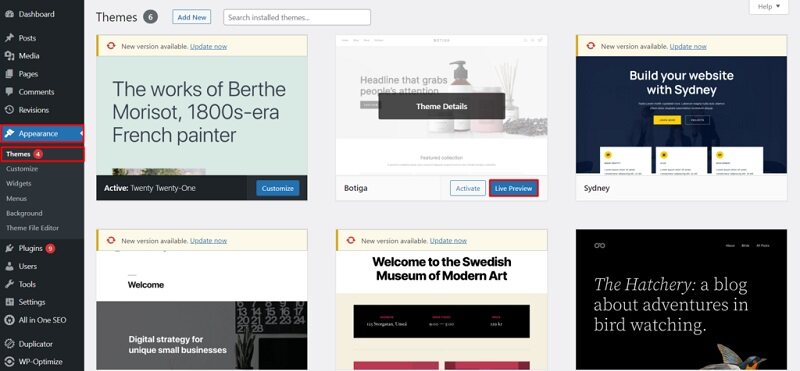
Following that, the WordPress Theme Customizer dashboard and the theme’s modification options ought to appear in the left sidebar.
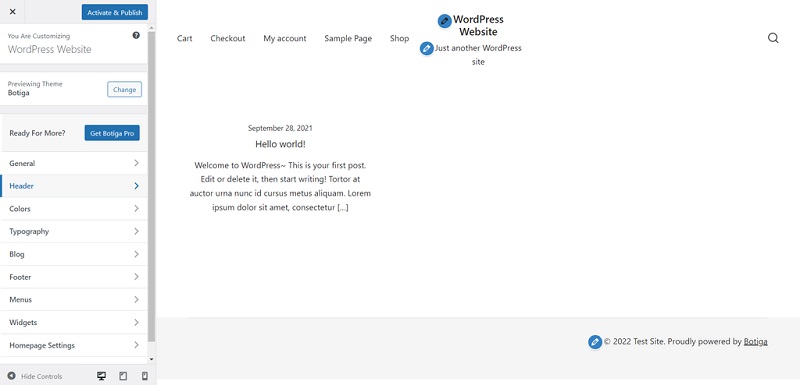
Expert users may use the Theme Editor to make changes to the WordPress theme files from the admin area, giving them access to more extensive customization possibilities.
One of the best ways to find out about the customizing possibilities available for the theme is to visit its website. On its website, Botiga, for instance, enumerates the design options that are offered in both free and paid editions.
The built-in theme builders in several well-known WordPress themes, such as Divi and Themify themes, may be used to better align and comprehend the modification choices.
3. Think about SEO
A WordPress theme has the power to impact the speed and stability of a website, two factors that are critical to search engine optimization (SEO).
Thus, stay away from selecting a theme that is overly complex and overstuffed with features and codes. An eye-catching theme with plenty of features could make a website load more slowly.
To make sure the theme is SEO-friendly, look for labels like SEO ready or anything similar in the theme description.
A theme that offers an extensive range of built-in templates and included plugins should be avoided since this might lead to bloat. Make sure you can turn off anything unnecessary to prevent your WordPress website from lagging.
4. Put responsiveness first
Given that over 90% of internet users worldwide access the internet via mobile devices, Google views mobile-friendliness as a crucial ranking criterion. For your website to be interesting and useful on every user’s device, you must utilize a responsive theme.
Although a lot of WordPress theme developers claim that their themes are responsive to mobile devices, we advise verifying the details. Copy and paste the URL of a theme’s demo site to Google’s Mobile-Friendly Test to do this.
Using the Developer Tool for Chrome is an alternative. Just right-click on the example site, choose Inspect, and either manually modify the screen dimension using the handles, or select your chosen screen size.
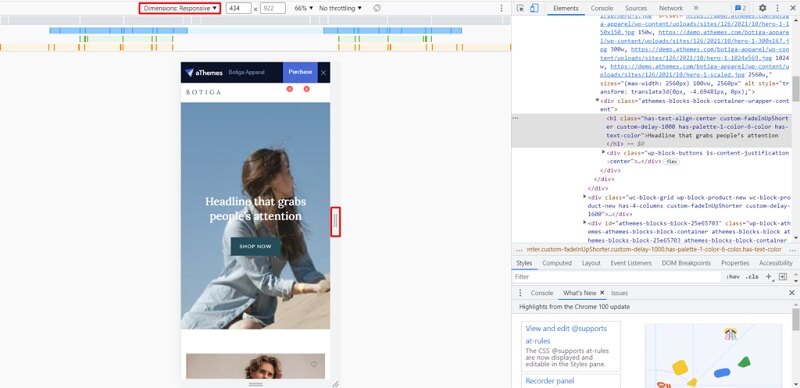
5. Check the compatibility of the plugin with the browser
Plugins give functionality to a website, while themes contribute to its appearance. Choose a theme that supports the plugins you require to prevent compatibility problems.
To find out more information, visit the theme’s official website, read the description, or get in touch with the creator.
Plugins that are well-liked and helpful, depending on the kind of your website, include:
- AIOSEO is an SEO plugin that allows you to assess the overall SEO performance of your website and add keywords and meta descriptions.
- For owners of internet businesses, WooCommerce is a WordPress eCommerce plugin.
- A form builder for creating order, survey, and contact forms is WPForms.
Certain website kinds can additionally require additional plugins. For example, a travel blogger can connect a mapping plugin, while a culinary blogger will need a recipe plugin.
Next, check to see if various browsers can use the WordPress theme. To check if the theme works and looks well, open the sample site on a few common browsers, such as Microsoft Edge and Google Chrome.
Conclusion
What WordPress theme is that gives a basic structure on which the layout and design of a website are created or based. An additional page builder or a customizer provided through the WordPress control panel can be used to alter specific components like layout and fonts.
Unlike templates, which only allow you to change a page’s appearance, WordPress themes have an impact on every page on your website. Several themes are directed at various niches, costs, and demands. Limited WordPress themes are almost easy to install but offer minimal options than paid WordPress themes that cover more since they offer more advanced options.
More Reading:-